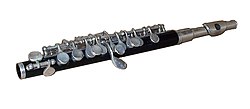Piccolo
 | |
| Woodwind instrument | |
|---|---|
| Classification | |
| Hornbostel–Sachs classification | 421.121.12-71 (Flute-like aerophone with keys) |
| Playing range | |
 The piccolo sounds one octave higher than written.  | |
| Related instruments | |
The piccolo (Italian for small) is a half-size flute, and a member of the woodwind family of musical instruments. The piccolo has the same fingerings as its larger sibling, the standard transverse flute, but the sound it produces is an octave higher than written. This gave rise to the name "ottavino," the name by which the instrument is referred to in the scores of Italian composers.
Piccolos are now only manufactured in the key of C; however, they were once also available in D♭. It was for this D♭piccolo that John Philip Sousa wrote the famous solo in the final repeat of the closing section (trio) of his march "The Stars and Stripes Forever".
In the orchestral setting, the piccolo player is often designated as Piccolo/Flute III or even Assistant Principal. The larger orchestras have designated this position as a Solo position due to the demands of the literature. Piccolos are often orchestrated to double (i.e. to play together with) the violins or the flutes, adding sparkle and brilliance to the overall sound because of the aforementioned one-octave transposition upwards. It is the highest-pitched instrument in an orchestra or band.[citation needed]
Concertos have been composed for piccolo, including those by Lowell Liebermann, Sir Peter Maxwell Davies, Todd Goodman[1], Martin Amlin,[2] Will Gay Bottje,[3] Bruce Broughton, Valentino Bucchi, Avner Dorman,[4] Justin Taylor (composer), Jean Doué, Michael Easton,[5] Egil Hovland, Guus Janssen, Tilo Medek, Dexter Morrill, Raymond Niverd, Daniel Pinkham, Thomas Schudel, and Allan Stephenson. Graham Waterhouse composed a Piccolo Quintet.
Traditional use
Historically, the piccolo had no keys, and should not be confused with the fife, or classical piccolo, which has a smaller bore and is therefore more strident. The piccolo is used in conjunction with marching drums in traditional formations at the Carnival of Basel, Switzerland.
The piccolo was originally made of wood and was featured in many prominent composers' works. One of the earliest pieces to use the piccolo was Beethoven's Symphony No. 5 in C Minor, playing only during the final (IV) movement. Today, piccolos are made from a range of materials, including plastic, resin, brass, nickel silver, silver, and a variety of hardwoods, most commonly grenadilla. Finely made piccolos are often available with a variety of options similar to the flute, such as the split-E mechanism. Most piccolos have a conical body with a cylindrical head, which is opposite of the flute. Unlike other woodwind instruments, in most wood piccolos the tenon joint connecting the head to the body has two interference fit points which surround both the cork and metal side of the piccolo body joint.
Bibliography
- The Complete Piccolo, compiled and edited by Jan Gippo, Theodore Presser Company, 2007/08. ISBN 1-59806-111-9
References
- ^ "Todd Goodman: Composer". Quincy Symphony Orchestra Association. Retrieved 2009-06-13.
- ^ Martin Amlin page of Presser website.
- ^ Will Gay Bottje Piccolo Concerto, American Composers' Alliance website.
- ^ Avner Dorman on the Cabrillo Music Festival website.
- ^ Concerto for Piccolo, Percussion and Strings, Australian Music Centre page.
External links
- Leonard Bernstein conducting "Stars and Stripes Forever," with the New York Philharmonic (1976).
- The Woodwind Fingering Guide, large, easy-to-navigate listing of piccolo fingerings
